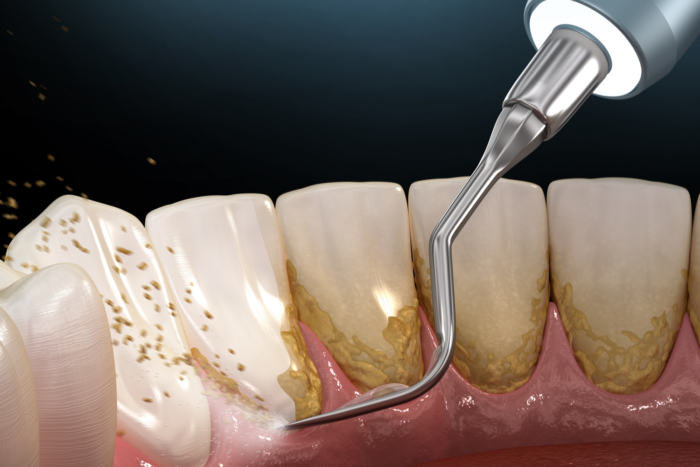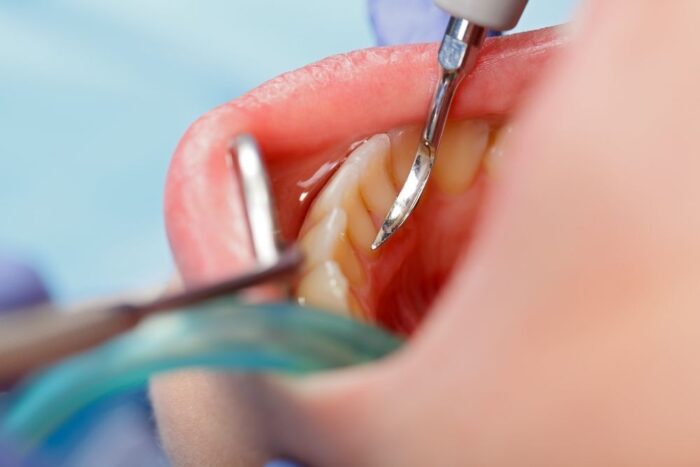
Periodontal treatment is a dental procedure that can be done by either a dentist or a periodontist – a dental specialist who focuses on gum disease. In some cases, a dental hygienist may also be involved in the treatment process.
The goal of periodontal treatment is to thoroughly clean the pockets around the teeth, removing any harmful bacteria and preventing damage to the gums and bone. This is achieved through a variety of techniques, including scaling, root planing, and potentially surgical procedures like gum graft surgery.
To ensure the ideal possible outcome from your treatment, it is important to maintain a daily oral care routine, which includes brushing and flossing regularly. Additionally, managing any underlying health conditions that may affect your dental health, such as diabetes, can help prevent future periodontal disease.
Discussed below are two main categories of periodontal treatments and their corresponding services:
Non-surgical Treatments

Non-surgical periodontal treatment may suit your specific condition, although these procedures have limitations. If non-surgical treatment fails to achieve good periodontal health, your periodontist may suggest surgery. The recommendation for surgery would depend on the particular needs of your case.
Scaling
Scaling is a common non-surgical periodontal treatment that helps remove plaque, tartar, and bacteria from tooth surfaces and below the gum line. The process may involve using manual instruments such as scalars or ultrasonic devices to break up and remove stubborn plaque and tartar accumulated on the teeth and around the gumline. Additionally, lasers can be used to remove tartar and bacteria effectively.
Scaling is typically recommended for patients with mild to moderate gum disease, also known as gingivitis or periodontitis. This procedure can help prevent further gum disease and promote better oral health. It is often performed with root planing, another non-surgical periodontal treatment, to achieve optimal results. Scaling and root planing are the first lines of treatment for patients with gum disease, and these procedures are usually effective in reversing the early stages of gum disease.
Root Planing
Root planing is a periodontal treatment to remove rough spots and bacteria from the tooth root’s surface. During this procedure, your dentist will use specialized instruments to clean the root surface thoroughly. By removing rough spots, bacteria, and other deposits from the tooth root, root planing helps prevent further tartar buildup and promotes the reattachment of gums to teeth.
Root planing is typically recommended for patients with periodontal disease, a bacterial infection affecting the gums and bone surrounding the teeth. Periodontal disease can cause tooth loss and other oral health problems if left untreated.
Root planing is an effective way to manage the disease and prevent further damage to the teeth and gums. It is often performed in conjunction with scaling to achieve optimal results. Your dentist will determine the appropriate treatment plan based on the severity of your periodontal disease.
Laser Treatment
In the treatment of periodontal disease, lasers are a viable option. Several controlled studies have reported comparable outcomes between laser treatment and other non-surgical alternatives, such as scaling and root planing.
Different lasers have varying wavelengths and power levels to ensure safe application during different periodontal procedures. However, using a laser with an unsuitable wavelength or power level can cause harm to periodontal tissues.
Tray Delivery Systems
Tray delivery systems are custom-made trays that fit precisely to the patient’s mouth, allowing for the precise delivery of medication prescribed by their dental provider. These trays are typically made from a mould of the patient’s mouth and can be used at home. The medication used in these trays can include antibiotics or other specialized treatments for periodontal disease.
Tray delivery systems have gained clearance from the FDA as they are considered safe and effective for delivering medication to gums. They are similar to fluoride trays commonly used to prevent tooth decay. The tray delivery system can provide a more targeted approach to treating periodontal disease, as the medication is applied directly to the gums where it is needed. This can lead to better results and less overall medication required compared to oral antibiotics, which are less targeted and can have side effects.
Your dental provider will determine if a tray delivery system is right for your case.
Surgical Periodontal Treatment

In some cases, periodontal disease may require surgical intervention by a periodontist to address both the disease and the damage it has caused. Periodontists receive an additional three years of specialized training after dental school and are highly skilled in performing gum surgery. They are also trained in administering comfort measures such as anesthesia or sedation during the procedure to ensure comfort.
Gum Graft Surgery
Gum graft surgery is a procedure that is performed when the gums start to recede or pull away from the teeth. This exposes the tooth roots and can cause sensitivity, decay, and even tooth loss. During the surgery, the dentist takes tissue from the roof of the mouth or a donor source and attaches it to the area where the gums have receded. This helps to cover the exposed root, prevent further bone loss and recession, and improve the appearance of your smile.
The procedure can be done on one or more teeth, depending on the extent of the recession. After the surgery, the patient may experience some discomfort, swelling, and bleeding. It is important to follow the dentist’s post-operative instructions, including taking prescribed pain medication and eating soft foods, to promote proper healing. Gum graft surgery can improve both the health and appearance of your smile, as well as alleviate any sensitivity or discomfort caused by gum recession.
Regenerative Procedures
Your periodontist may advise a regenerative therapy to help replace the bone supporting your teeth if periodontal disease has harmed it. This procedure involves the removal of bacteria that cause the disease and using membranes, bone grafts, or tissue-stimulating proteins to stimulate your body’s natural ability to regenerate lost bone and tissue. Your periodontist will initially pull back the gum tissue to begin the treatment.
Dental Crown Lengthening
Some people’s teeth may appear short due to abundant gum tissue, even though they are the right length. This problem is treatable with a dental crown lengthening treatment. The periodontist reshapes extra gum and bone tissue throughout the treatment to display more of the natural tooth.
The procedure can be performed on a single tooth or several teeth to achieve an even gum line and a natural, broader smile. Additionally, a dentist or periodontist may recommend dental crown lengthening to facilitate a restorative or cosmetic dental procedure by adjusting the bone level and gum to expose more of the tooth.
Periodontal Pocket Procedures
To support your teeth, your gum and bone tissues should fit snugly around them. However, periodontal disease can destroy these tissues, forming pockets around the teeth. These pockets can become deeper over time, providing a breeding ground for bacteria and leading to further loss of bone and tissue. Ultimately, extensive bone loss may require tooth extraction.
To address this issue, a periodontal pocket procedure involves your periodontist folding back the gum tissue and removing the harmful bacteria before repositioning the tissue. In some cases, damaged bone surfaces are smoothed to reduce areas where bacteria can hide, enabling the gum tissue to reattach more effectively to healthy bone.

Bottomline
Periodontal disease is a serious health condition that can lead to health complications if left untreated. However, with the help of a periodontist and the right periodontal treatment plan, it can restore oral health and prevent further damage.
It is important to work closely with your dentist to determine the ideal course of treatment for your unique case and to maintain good oral hygiene habits to prevent periodontal disease from occurring or recurring.
















